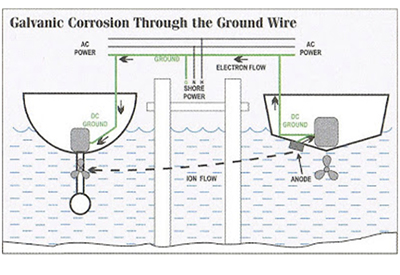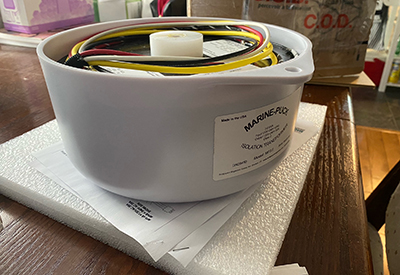Ask Andrew: Corrosion – How to be a good neighbor: catch strays

Sept 23, 2021
an illustration of stray current between boats at dock
Before I knew about corrosion, or marine electrical (or boats in general), I would see ‘no swimming’ signs at marinas and assume that the area was off limits due to boat traffic. Now that I know a bit more; the greater risk has to do with corrosion, grounding, and stray current issues.
Our last two CYOB issues have covered galvanic and stray-current corrosion, respectively; but so far we’ve only looked at the way that stray-current and the galvanic series affects one boat (your own). But a vessel with the elements present for corrosion to occur doesn’t sit within a bubble. Quite the contrary: boats lined up at a marina or a yacht club, each plugged in to shore power, each with the potential for 12V stray-current, and each with different metals present beneath the water line present a perfect storm for corrosion to occur.
When a boat is plugged into shore, the AC shore power plug and cable have three wires: the hot (black), neutral (white) and grounding (green) wires. Normally, the green grounding wire is a non-current carrying wire. It’s there as a safety, to take any stray current and provide a path for that stray current to easily find ground.
Aboard your boat, behind the electrical panel, this AC grounding wire is bonded to the DC system. This allows for any stray current from the DC system to find an easy path to ground. The DC bonding system links all the metal components (through hulls, shafts, props, drives, the engine block, trim tabs, etc). But if the camera is zoomed out to see an overview of the dock, or the marina as a whole, we can see that all of the underwater components aboard your boat are linked to the DC system and batteries, in turn linked to the AC system, in turn linked to the shore-power post, in turn linked to the rest of the shore power posts, in turn linked to every other boat along the dock.
This means that corrosion doesn’t only happen aboard your own boat – but it takes place between the linked boats, as well. Galvanic corrosion can occur between underwater pilings, dock struts, and neighbors along the same dock. Similarly, stray current on your neighbors boat can find a path to ground through your boat (causing swift corrosion of your underwater metallic components).
 an example of a galvanic isolator.
an example of a galvanic isolator.
Try keeping that thought out of your mind the next time you see your dock-neighbor performing his/her own onboard electrical….
So how do you break the cycle? How do you prevent 12V DC stray-current, and minimize galvanic corrosion between vessels? More than that, how to you prevent the water between vessels from being energized by 110V AC stray current?
Remember: A stray current is looking for ground. The normal electrical path from the positive post of the 12V battery, through the appliance, and back to the battery’s negative post is broken. But because the electrical current can’t use the regular route, it seeks an alternative. It will take the shortest and quickest path it can find to get back to ground.
 a wiring diagram showing how an isolation transformer keeps a boat as a self-contained entity while at dock.
a wiring diagram showing how an isolation transformer keeps a boat as a self-contained entity while at dock.
Imagine this example, from last edition on stray-current corrosion:
One of the wires running to automatic float-operated bilge pump was crimped, but not watertight. Current runs from the connection through the bilge water to a metal through-hull fitting. Current continues to flow into the water around the boat, through the propeller and shaft, to the engine block, which is where a common ground exists, and runs back to the negative post of the battery. The circuit is still complete, but through a much more irregular (and unintentional) route. Electricity is lazy, and it will always find the most direct path to complete its circuit
The result of this may be that the propeller, shaft, sail drive or stern drive may become severely corroded within hours or days.
Now let’s look at a new scenario, where we take into consideration that the shore power pedestal that the boat is plugged into, as well as the other pedestals and boats along the dock are all interconnected through the individual bonding systems aboard each vessel.
So imagine this, instead:
One of the wires running to your automatic float-operated bilge pump was crimped, but not watertight. Current runs from the connection through the bilge water to a metal through-hull fitting. Current continues to flow into the water around the boat, through to your neighbour’s propeller and shaft, to their engine block, which is where a common ground exists, which is bonded to the shore power pedestal and common ground at the dock.
The result of this may be that your dock neighbour’s propeller, shaft, sail drive or stern drive may become severely corroded within hours or days.
 this isolation transformer is about 10” in diameter and weighs about 50lbs!
this isolation transformer is about 10” in diameter and weighs about 50lbs!
What’s the solution? How do you have multiple boats plugged into shore power, each independently electrically safe and secure by using appropriate bonding systems – but without the potential of electrically feeding off of each other?
The answer is to employ a galvanic isolator.
A galvanic isolator allows your boat to be plugged into shore power, and allows AC current to flow into your boat to power outlets and battery chargers, but prevents DC current flow between your boat and dock. This means that the DC connection is severed, meaning that any stray current leaving your boat can only find a path to ground through your boat.
Be aware of 110!
There is a point of confusion here that I’d like to clear up. Up until this point, we’ve been talking about stray current in the DC 12V system. This is the current generated by your boat’s battery system. Any stray current from the batteries can cause corrosion.
A highly related (and much more dangerous) phenomenon exists when there is stray current in the AC 110V system.
In this case, an AC appliance onboard – a battery charger, a water heater or a faulty outlet – is allowing stray current to run into bilge water, through a metallic underwater fitting and into the water surrounding the boat. That stray current is in search of ground, just as in our earlier bilge pump example. With each boat along the dock plugged into shore power, the stray current will seek the most direct path to ground, by flowing through the water and back to a shore power connection. The difference here is the voltage: 12V will cause corrosion. 110V stray current can cause paralysis or death to anyone in its path – including a swimmer in the water between boats.
Similar in function to a galvanic isolator for the 12V system, an isolation transformer can be employed for the 110V AC system
An isolation transformer allows current to flow from the shore power post to the boat. It is hard-wired to the boat’s shore-power plug and it’s design allows current to flow from the shore power plug to the AC breaker panel through the principle of electromagnetic induction: There is a break in the wiring, and the isolation transformer allows current to cross that break without being hard-wired. On a practical level, this means than any stray current or AC faults aboard your boat will be contained to your boat. They won’t affect the dockside shore power pedestal, the water around your boat, or the boats nearby (and vice versa). Isolation transformers are heavy, large, and expensive – and because of this, their use is quite rare aboard. That said, their advantages as a safety device can’t be overstated.
So next time electrical work or upgrades are being considered, think of the possibility of stray-current, and the implications including corrosion damage and electric shock drowning. To help keep you (and your neighbors) safe, consider the use of a galvanic isolator to protect against 12V stray current corrosion, or an isolation transformer to prevent 110V stray current in the water.
 Andrew McDonald is the owner of Lakeside Marine Services – a boat repair/maintenance firm based in Toronto. Andrew has worked in the marine industry for 12 years and is a graduate of the Georgian College ‘Mechanical Techniques – Marine Engine Mechanic’ program.
Andrew McDonald is the owner of Lakeside Marine Services – a boat repair/maintenance firm based in Toronto. Andrew has worked in the marine industry for 12 years and is a graduate of the Georgian College ‘Mechanical Techniques – Marine Engine Mechanic’ program.
Questions or comments for Andrew? Email him directly via: askandrew@lakesidemarineservices.ca




























